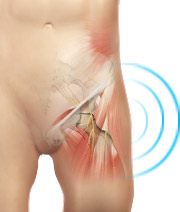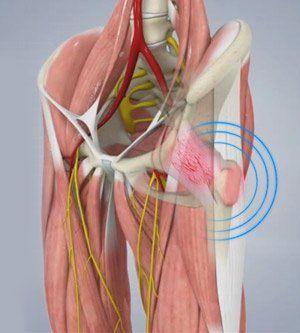Snapping Hip
Hip Pain

The hip is an important joint that helps us walk, run and jump. The ball-and-socket joint in the hip is formed between the round end of the femur (thigh bone) and the cup-shaped socket of the acetabulum (part of the pelvis bone). Joint stability in the hip region is achieved through the labrum (a strong fibrous cartilage), which covers the acetabulum and seals it, ligaments (tissue connecting bone to bone including the hip capsule) and tendons (tissue connecting muscle to bone) that encase the hip and control the hip movements.
Snapping hip syndrome is a condition in which you hear or feel a snapping sound in the hip while swinging your legs, running, walking or while getting up from the chair. Movement of the muscles or tendons over a bony protrusion in the hip region gives rise to the snapping sound, which can occur in the back, front or side of the hip. It is usually painless and harmless, but may be accompanied with pain and weakness in some. People who are involved in sports or dance where they must repeatedly bend are most vulnerable and it may affect their performance. Sometimes, the syndrome can lead to bursitis, a painful swelling of the fluid-filled sacs called bursae that cushion the hip joint.
Causes
The most common cause of snapping hip syndrome is tightness in the muscles and tendons surrounding the hip. Sometimes, a loose piece of cartilage, a cartilage tear or pieces of broken cartilage or bone in the joint space can lead to the snapping sound. This may also lock the hip causing disability along with the pain. However, this is less common.
Diagnosis

Dr. Mansour will discuss your medical history and symptoms with you, and will conduct a physical examination to detect the exact cause of snapping. You may be asked to reproduce the snapping sound by moving your hip in different directions. Imaging tests may be ordered to rule out bone and joint problems.
Treatment
Rest and modification of activities may be suggested initially followed by conservative therapeutic options. The therapeutic strategies for snapping hip include:
Home care
A few home remedies can be followed if you experience minor snapping hip pain, which include:
- Applying ice to the affected area
- Using NSAIDs to reduce discomfort
- Avoiding repetitive hip movements by changing your activities
Consult Dr. Mansour if the discomfort persists even after following the home remedies.
Physical Therapy
Dr. Mansour may teach you certain exercises to strengthen and stretch the musculature surrounding the hip. You may be guided by a physical therapist. Specific tendon stretching exercises such as iliotibial band stretch and piriformis stretch will be indicated depending on the type of snapping you experience.
Corticosteroid Injection
Dr. Mansour may recommend a corticosteroid to be injected into the bursa to reduce the pain and inflammation in the hip joint in case you have hip bursitis. Many times this can be performed during the same office visit.
Surgical Treatment
Surgery is very uncommon for this condition and may be recommended when conservative approaches do not have an effect in resolving the snapping hip syndrome and there is no other underlying cause of the condition, such as hip dysplasia or increased femoral anteversion(which is rare). The type of surgery will depend on the factors that cause snapping hip. Surgical procedures include:
- Hip arthroscopy:This procedure is usually used to remove or repair the torn labrum. Dr. Mansour will insert an arthroscope (small camera) into your hip joint so that minute surgical instruments can be guided with the help of images displayed on a large screen. Very small cuts are required for this procedure due to the presence of a small arthroscope and surgical instruments.
- Open procedure:The open surgery can help Dr. Mansour to gain better access to some of the most complex hip problems. An open incision of several centimeters will be made to resolve the issue of snapping hip.
Dr. Mansour will discuss the best surgical option depending on your situation.












